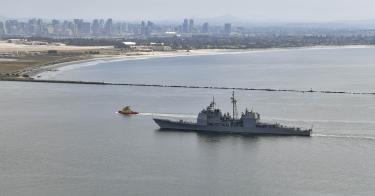We used to make so many ships. We don’t make them anymore very much, but we’re going to make them very fast, very soon.”
That’s what President Trump said when he issued his executive order to restore America’s maritime dominance. Many in Congress have voiced their support, but there’s a major problem: The budget doesn’t reflect it. Unless lawmakers make big changes or pursue a separate naval act with large block buys of warships, they will fail to send the required demand signal to the shipbuilding industry.
Increasing shipbuilding capacity requires ship orders. “Put in the orders, finance shipyard expansion, and stand back”—that’s how industrialist Bill Knudsen unleashed the nation’s massive naval buildup prior to and during World War II.
Today, Congress and the president have a rare opportunity, through reconciliation and the fiscal year 2026 budget, to reverse the nation’s maritime decline. Yet the procurement dollars for warships are nowhere near where they need to be.
Senator Roger Wicker (R., Miss.) recently captured growing exasperation: “I am disturbed by the shipbuilding account, which plummeted to $20.8 billion from last year’s $37 billion. . . . This shortfall reflects efforts to game the budget in anticipation of congressional reconciliation funds, which were intended as supplemental, not a substitute.”
>>> Shipbuilding Revitalization Requires Reforms from the Navy, Shipbuilders, and Congress Alike
As the debate continues in Washington, the clock is fast ticking down to a showdown in Asia as China’s Communist Party bolsters its military advantages by building warships—400 to the U.S. Navy’s 292, and shipbuilding capacity more than 200 times greater than America’s.
In short, we need a bigger Navy—and delaying orders for warships is counterproductive.
President Trump has repeatedly stated that revitalizing the nation’s commercial and naval shipbuilding industries is a national priority; however, we do not have the warship orders needed for Fiscal Year 2026 to allow investment in infrastructure and labor at shipyards.
While the reconciliation bill contains tons of important funding for Golden Dome, munitions, and airpower, the warships being ordered are below what is needed. Now it will likely fall to the National Defense Authorization Act or a separate naval act to deliver the orders for the warships needed to send a demand signal that exceeds what the current shipbuilding plan calls for.
Had past commitments been held to building a 355-ship Navy, which is memorialized in law by Congress (NDAA FY18 sec. 1025), the Navy would have 318 warships today instead of 292. The reality, after decades of such malaise, is that the Navy needs a new public shipyard to keep our too small nuclear fleet at sea (66 submarines required, today there are 47), and recent hearings make clear the nation hasn’t got the shipbuilding capacity to build a fleet to pace the threat from China.
This decade-long slide cannot be reversed overnight. Building ships already in series production can take three to five years, while adding new suppliers to the defense industrial base can take two to three years—all late to the task when it comes to deterring China. That makes the following three imperatives vital:
- Operate the fleet in new ways and complicate operational planning for China’s Secretary General Xi Jinping. The option to use aggression will appear increasingly unrealistic without the minimum of ships and munitions to back it up, especially as allies such as Japan and the Philippines are also bolstering their defenses.
- Invest in the capacity to build and repair warships. This includes building novel unmanned vessels able to be put to sea faster than conventionally designed and operated warships. At the same time, Congress and the president need to provide a significant order of new warships, backed by a budget, to fund the necessary infrastructure. This is the intent of a proposed Naval Act and new contracting mechanisms, such as SAWS.
- Increase ship orders above the planned shipbuilding plan to fuel infrastructure expansion. Buy more than two Virginia-class subs and more than two Arleigh Burke–class destroyers, fund aircraft carriers ahead of time, and put as much funding and advanced procurement orders into shipbuilding accounts to send business that grows the supplier base.
Today, there is a rare opportunity to make needed investments to grow naval industrial capacity, founded on orders for warships, in time to respond to a conflict this decade. Sadly, recent rumors of lackluster warship orders in budgets being contemplated, if true, fail to demonstrate the urgency that President Trump has called for in revitalizing shipbuilding and expanding the U.S. Navy.
>>> U.S., Navy Must Do More To Address China’s Growing Maritime Threat
We need a budget for a naval expansion. Anything less is not dealing with reality.
Underfunding and ordering only one attack submarine in FY 2026 also jeopardizes wider strategic efforts. Hence, we need to be ordering a minimum of two (preferably more) Virginia-class subs a year, both to meet Navy plans and to ensure the success of initiatives such as AUKUS. Similar increases are needed for orders of destroyers, frigates, and amphibs.
The bill for the nation’s defense is due, and the momentum and political capital to fix shipbuilding are available now. The president and the American people want to revitalize American shipbuilding and the U.S. Navy, but without increased procurement dollars and expanded orders, the reforms and infrastructure investments won’t be enough.
Shipyards exist to build ships, but without orders, nothing happens. It’s time for Congress to change that.
This piece originally appeared in the National Review





